Exploring Leadership Values: An Assessment in Public Health Context
VerifiedAdded on 2023/03/31
|5
|753
|306
Essay
AI Summary
This essay presents a student's assessment of values in leadership, specifically within the context of public health. It differentiates between leadership and management, emphasizing the importance of values such as honesty, integrity, humility, justice, and fairness in effective leadership. The author reflects on the "Golden Rule" and personal values that contribute to their leadership approach. The value system assessment has shaped the author's view on public health leadership, highlighting the need for innovation, partnerships, and a focus on community well-being over selfish ambitions. The essay concludes by emphasizing the importance of implementing strategies based on prioritized values to improve performance and service provision within healthcare organizations, aiming for the good of the entire community.
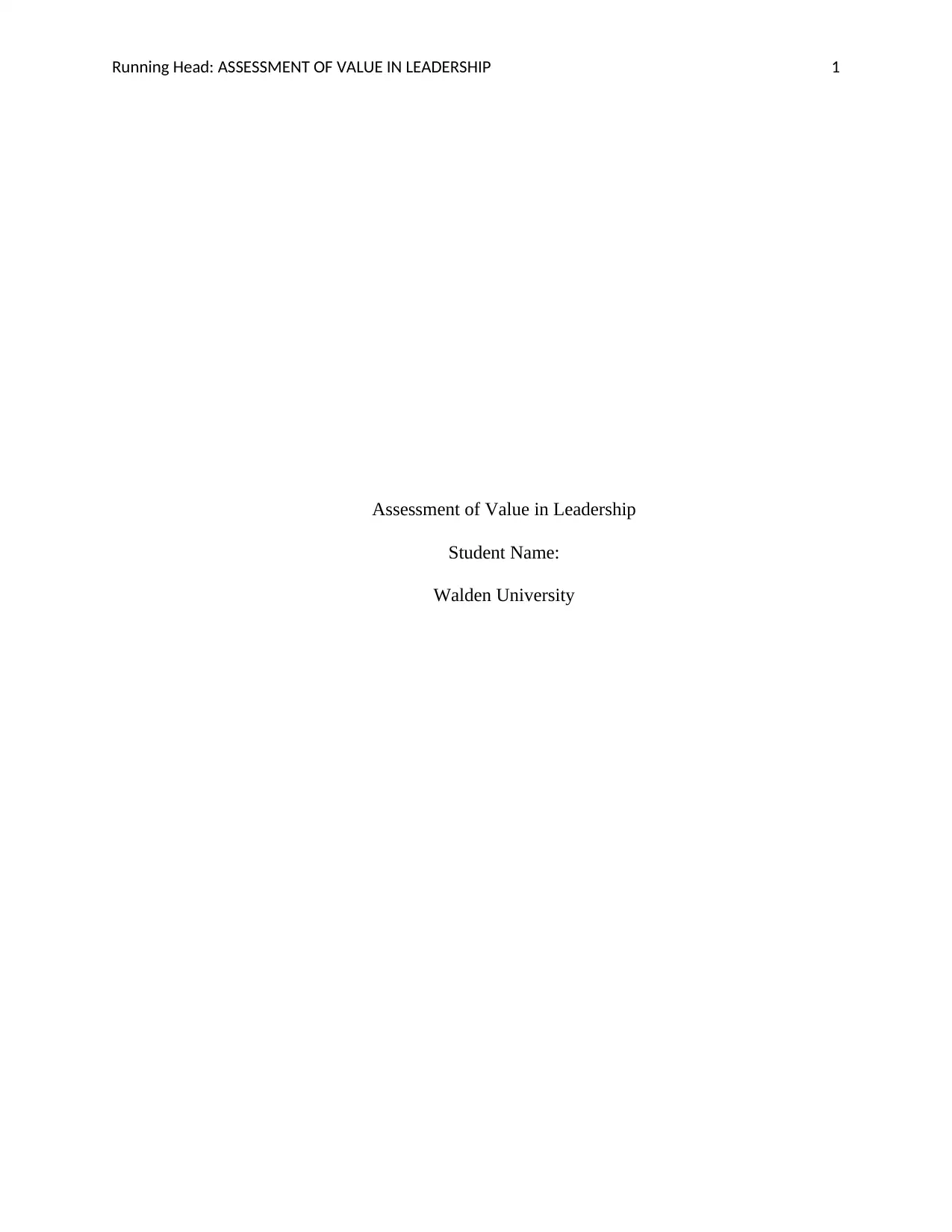
Running Head: ASSESSMENT OF VALUE IN LEADERSHIP 1
Assessment of Value in Leadership
Student Name:
Walden University
Assessment of Value in Leadership
Student Name:
Walden University
Paraphrase This Document
Need a fresh take? Get an instant paraphrase of this document with our AI Paraphraser
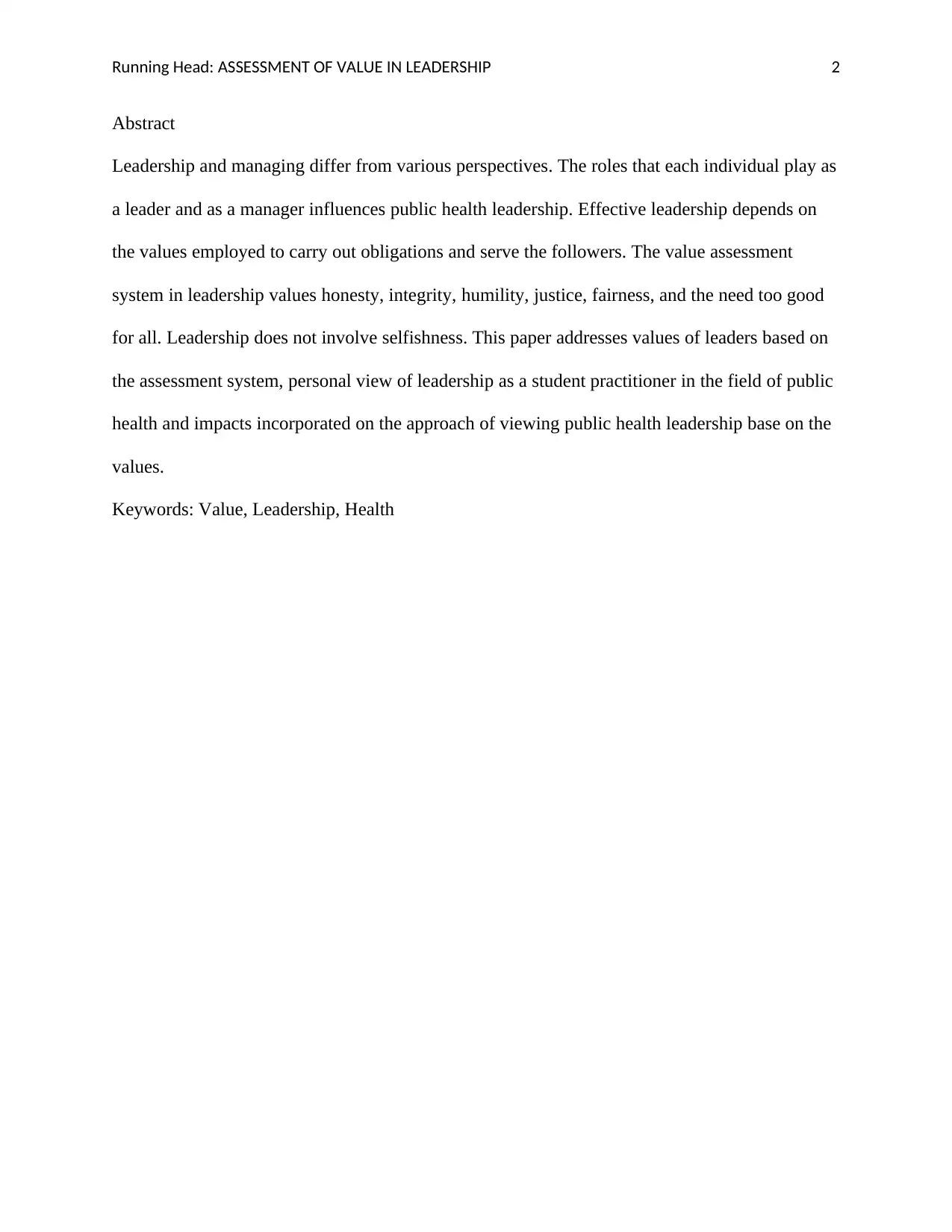
Running Head: ASSESSMENT OF VALUE IN LEADERSHIP 2
Abstract
Leadership and managing differ from various perspectives. The roles that each individual play as
a leader and as a manager influences public health leadership. Effective leadership depends on
the values employed to carry out obligations and serve the followers. The value assessment
system in leadership values honesty, integrity, humility, justice, fairness, and the need too good
for all. Leadership does not involve selfishness. This paper addresses values of leaders based on
the assessment system, personal view of leadership as a student practitioner in the field of public
health and impacts incorporated on the approach of viewing public health leadership base on the
values.
Keywords: Value, Leadership, Health
Abstract
Leadership and managing differ from various perspectives. The roles that each individual play as
a leader and as a manager influences public health leadership. Effective leadership depends on
the values employed to carry out obligations and serve the followers. The value assessment
system in leadership values honesty, integrity, humility, justice, fairness, and the need too good
for all. Leadership does not involve selfishness. This paper addresses values of leaders based on
the assessment system, personal view of leadership as a student practitioner in the field of public
health and impacts incorporated on the approach of viewing public health leadership base on the
values.
Keywords: Value, Leadership, Health
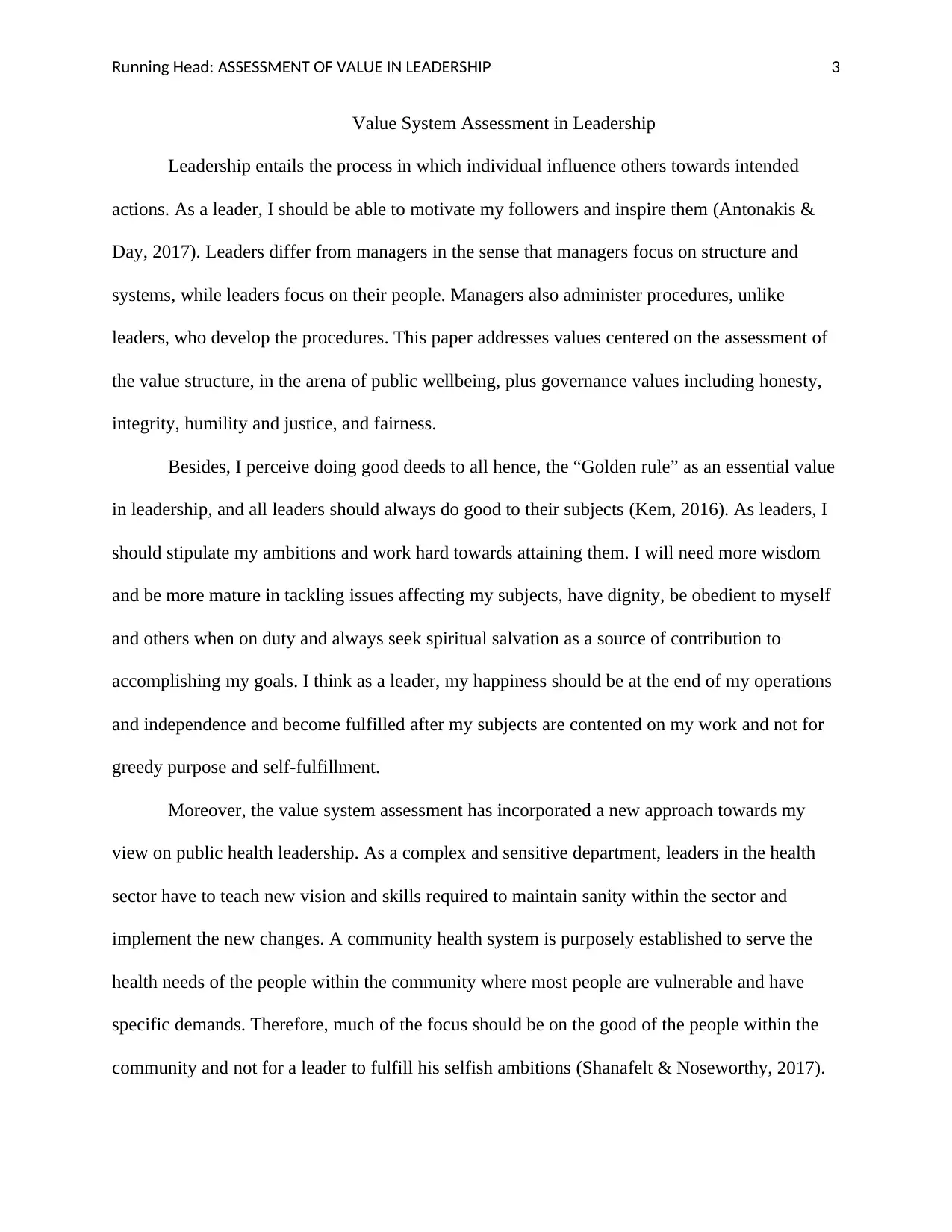
Running Head: ASSESSMENT OF VALUE IN LEADERSHIP 3
Value System Assessment in Leadership
Leadership entails the process in which individual influence others towards intended
actions. As a leader, I should be able to motivate my followers and inspire them (Antonakis &
Day, 2017). Leaders differ from managers in the sense that managers focus on structure and
systems, while leaders focus on their people. Managers also administer procedures, unlike
leaders, who develop the procedures. This paper addresses values centered on the assessment of
the value structure, in the arena of public wellbeing, plus governance values including honesty,
integrity, humility and justice, and fairness.
Besides, I perceive doing good deeds to all hence, the “Golden rule” as an essential value
in leadership, and all leaders should always do good to their subjects (Kem, 2016). As leaders, I
should stipulate my ambitions and work hard towards attaining them. I will need more wisdom
and be more mature in tackling issues affecting my subjects, have dignity, be obedient to myself
and others when on duty and always seek spiritual salvation as a source of contribution to
accomplishing my goals. I think as a leader, my happiness should be at the end of my operations
and independence and become fulfilled after my subjects are contented on my work and not for
greedy purpose and self-fulfillment.
Moreover, the value system assessment has incorporated a new approach towards my
view on public health leadership. As a complex and sensitive department, leaders in the health
sector have to teach new vision and skills required to maintain sanity within the sector and
implement the new changes. A community health system is purposely established to serve the
health needs of the people within the community where most people are vulnerable and have
specific demands. Therefore, much of the focus should be on the good of the people within the
community and not for a leader to fulfill his selfish ambitions (Shanafelt & Noseworthy, 2017).
Value System Assessment in Leadership
Leadership entails the process in which individual influence others towards intended
actions. As a leader, I should be able to motivate my followers and inspire them (Antonakis &
Day, 2017). Leaders differ from managers in the sense that managers focus on structure and
systems, while leaders focus on their people. Managers also administer procedures, unlike
leaders, who develop the procedures. This paper addresses values centered on the assessment of
the value structure, in the arena of public wellbeing, plus governance values including honesty,
integrity, humility and justice, and fairness.
Besides, I perceive doing good deeds to all hence, the “Golden rule” as an essential value
in leadership, and all leaders should always do good to their subjects (Kem, 2016). As leaders, I
should stipulate my ambitions and work hard towards attaining them. I will need more wisdom
and be more mature in tackling issues affecting my subjects, have dignity, be obedient to myself
and others when on duty and always seek spiritual salvation as a source of contribution to
accomplishing my goals. I think as a leader, my happiness should be at the end of my operations
and independence and become fulfilled after my subjects are contented on my work and not for
greedy purpose and self-fulfillment.
Moreover, the value system assessment has incorporated a new approach towards my
view on public health leadership. As a complex and sensitive department, leaders in the health
sector have to teach new vision and skills required to maintain sanity within the sector and
implement the new changes. A community health system is purposely established to serve the
health needs of the people within the community where most people are vulnerable and have
specific demands. Therefore, much of the focus should be on the good of the people within the
community and not for a leader to fulfill his selfish ambitions (Shanafelt & Noseworthy, 2017).
⊘ This is a preview!⊘
Do you want full access?
Subscribe today to unlock all pages.

Trusted by 1+ million students worldwide
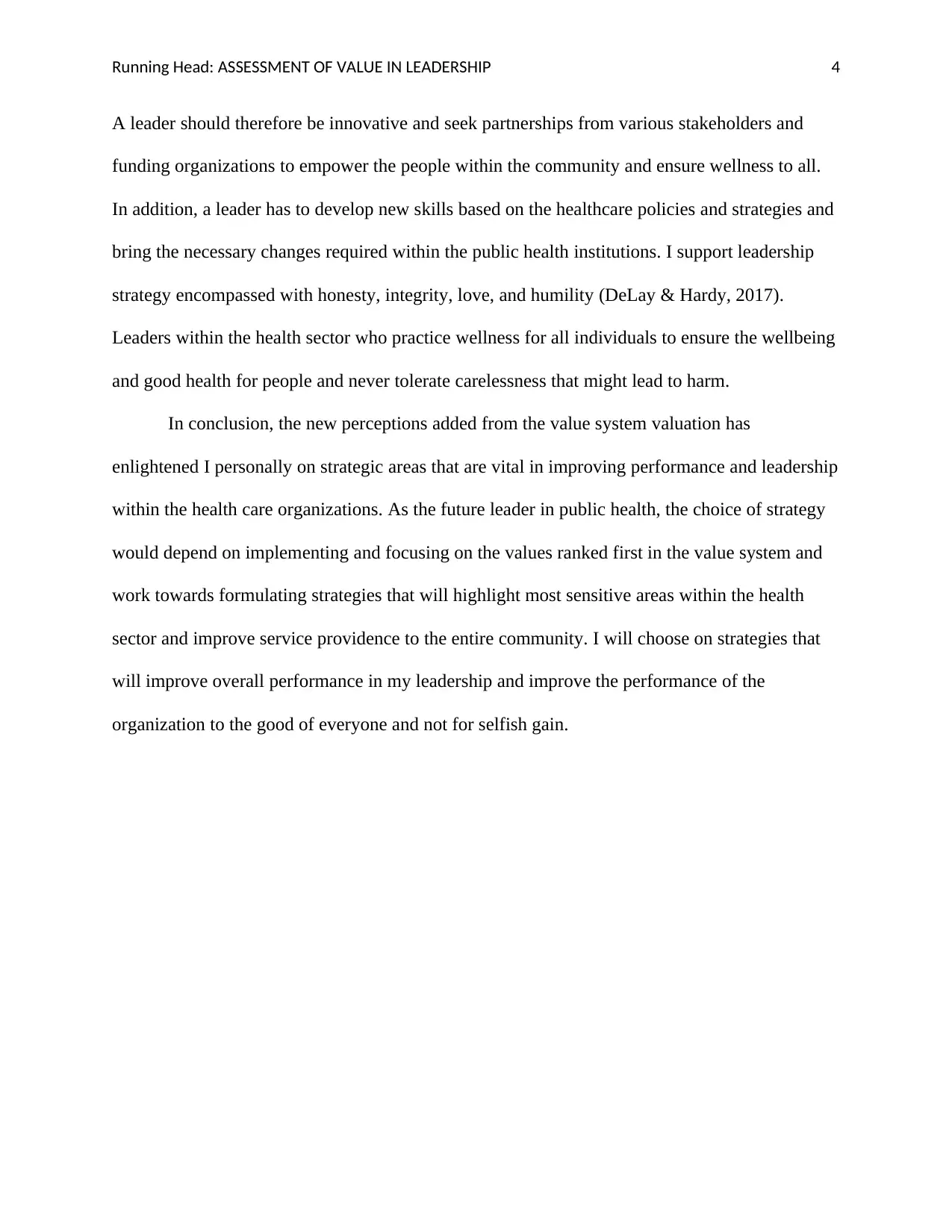
Running Head: ASSESSMENT OF VALUE IN LEADERSHIP 4
A leader should therefore be innovative and seek partnerships from various stakeholders and
funding organizations to empower the people within the community and ensure wellness to all.
In addition, a leader has to develop new skills based on the healthcare policies and strategies and
bring the necessary changes required within the public health institutions. I support leadership
strategy encompassed with honesty, integrity, love, and humility (DeLay & Hardy, 2017).
Leaders within the health sector who practice wellness for all individuals to ensure the wellbeing
and good health for people and never tolerate carelessness that might lead to harm.
In conclusion, the new perceptions added from the value system valuation has
enlightened I personally on strategic areas that are vital in improving performance and leadership
within the health care organizations. As the future leader in public health, the choice of strategy
would depend on implementing and focusing on the values ranked first in the value system and
work towards formulating strategies that will highlight most sensitive areas within the health
sector and improve service providence to the entire community. I will choose on strategies that
will improve overall performance in my leadership and improve the performance of the
organization to the good of everyone and not for selfish gain.
A leader should therefore be innovative and seek partnerships from various stakeholders and
funding organizations to empower the people within the community and ensure wellness to all.
In addition, a leader has to develop new skills based on the healthcare policies and strategies and
bring the necessary changes required within the public health institutions. I support leadership
strategy encompassed with honesty, integrity, love, and humility (DeLay & Hardy, 2017).
Leaders within the health sector who practice wellness for all individuals to ensure the wellbeing
and good health for people and never tolerate carelessness that might lead to harm.
In conclusion, the new perceptions added from the value system valuation has
enlightened I personally on strategic areas that are vital in improving performance and leadership
within the health care organizations. As the future leader in public health, the choice of strategy
would depend on implementing and focusing on the values ranked first in the value system and
work towards formulating strategies that will highlight most sensitive areas within the health
sector and improve service providence to the entire community. I will choose on strategies that
will improve overall performance in my leadership and improve the performance of the
organization to the good of everyone and not for selfish gain.
Paraphrase This Document
Need a fresh take? Get an instant paraphrase of this document with our AI Paraphraser
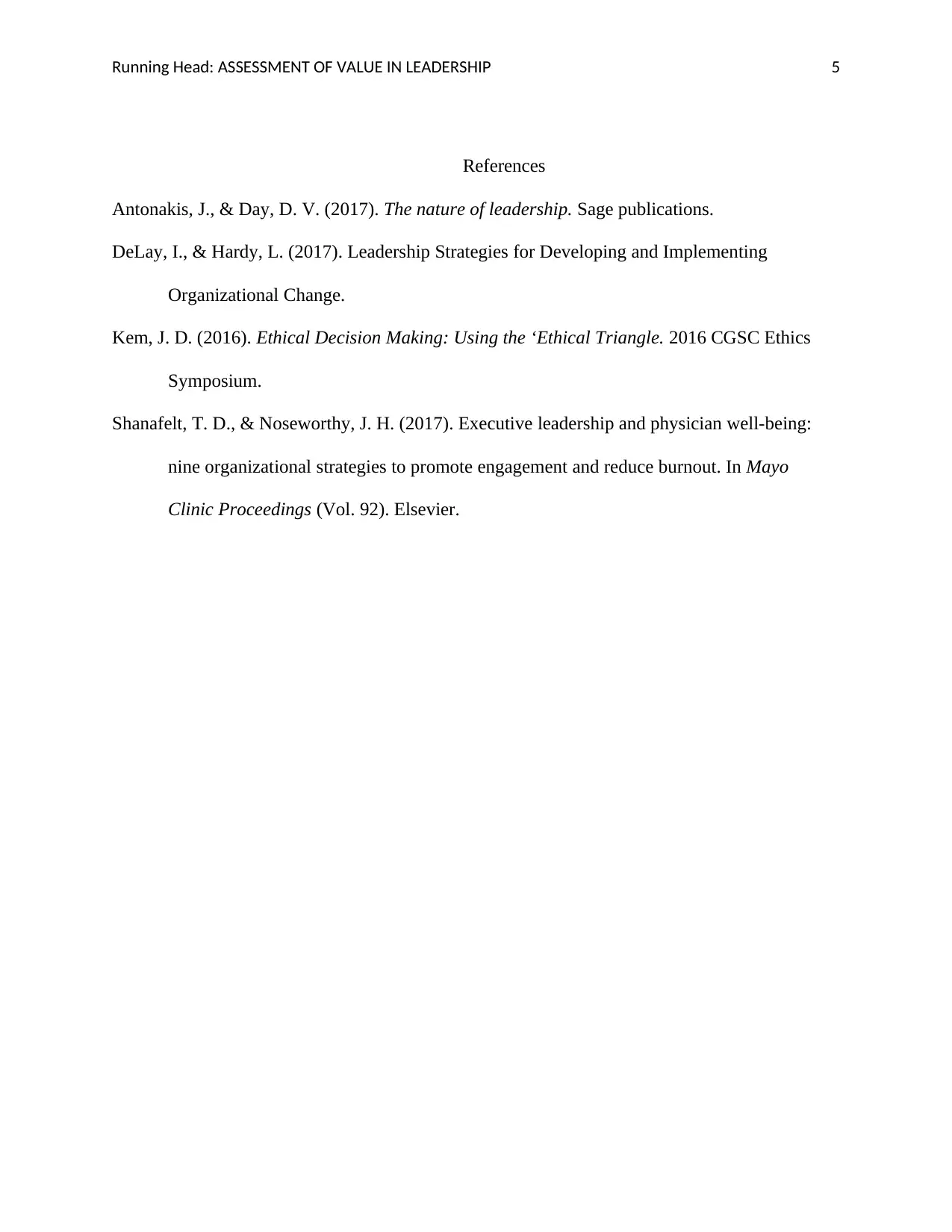
Running Head: ASSESSMENT OF VALUE IN LEADERSHIP 5
References
Antonakis, J., & Day, D. V. (2017). The nature of leadership. Sage publications.
DeLay, I., & Hardy, L. (2017). Leadership Strategies for Developing and Implementing
Organizational Change.
Kem, J. D. (2016). Ethical Decision Making: Using the ‘Ethical Triangle. 2016 CGSC Ethics
Symposium.
Shanafelt, T. D., & Noseworthy, J. H. (2017). Executive leadership and physician well-being:
nine organizational strategies to promote engagement and reduce burnout. In Mayo
Clinic Proceedings (Vol. 92). Elsevier.
References
Antonakis, J., & Day, D. V. (2017). The nature of leadership. Sage publications.
DeLay, I., & Hardy, L. (2017). Leadership Strategies for Developing and Implementing
Organizational Change.
Kem, J. D. (2016). Ethical Decision Making: Using the ‘Ethical Triangle. 2016 CGSC Ethics
Symposium.
Shanafelt, T. D., & Noseworthy, J. H. (2017). Executive leadership and physician well-being:
nine organizational strategies to promote engagement and reduce burnout. In Mayo
Clinic Proceedings (Vol. 92). Elsevier.
1 out of 5
Related Documents
Your All-in-One AI-Powered Toolkit for Academic Success.
+13062052269
info@desklib.com
Available 24*7 on WhatsApp / Email
![[object Object]](/_next/static/media/star-bottom.7253800d.svg)
Unlock your academic potential
Copyright © 2020–2025 A2Z Services. All Rights Reserved. Developed and managed by ZUCOL.





